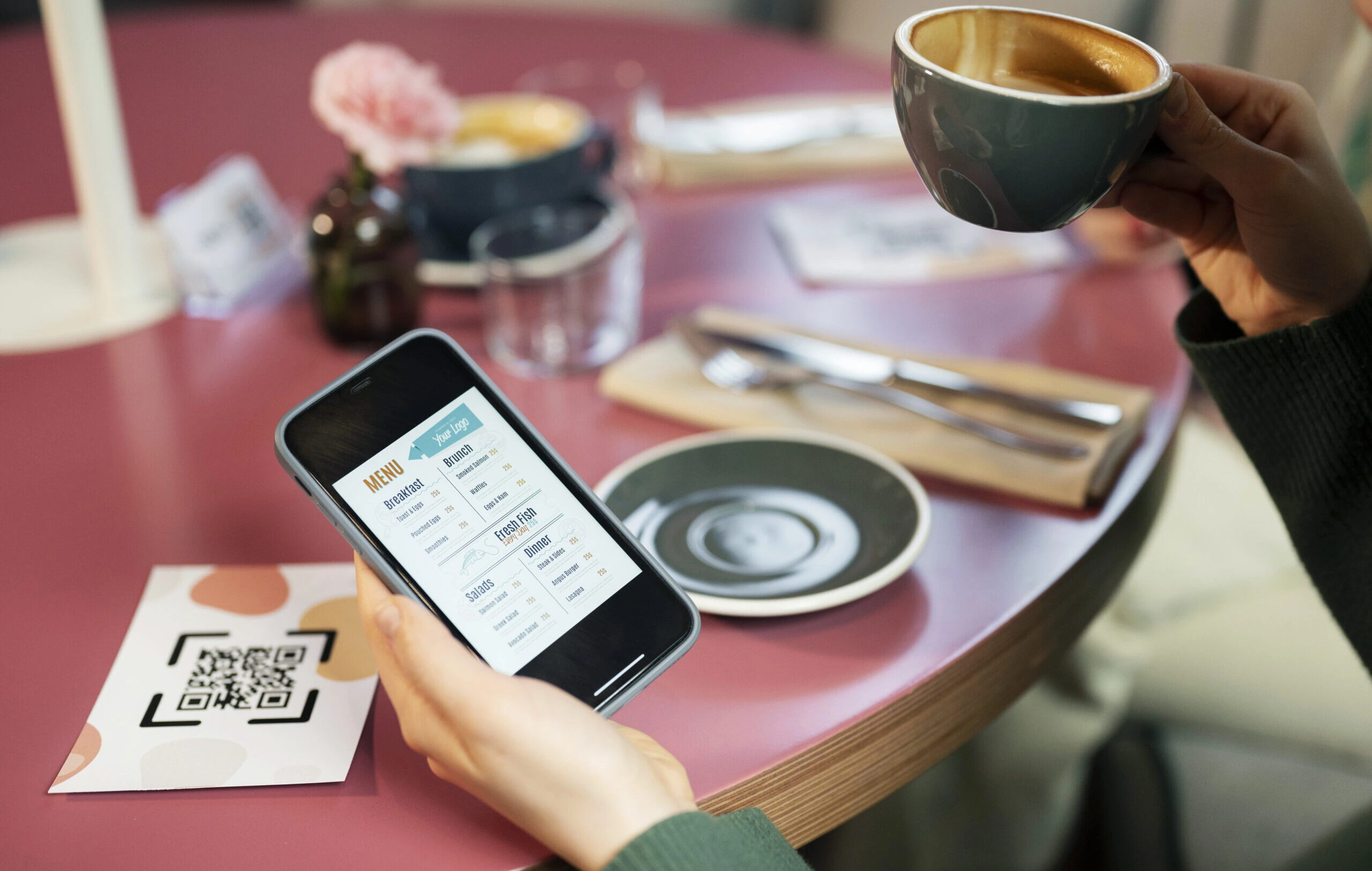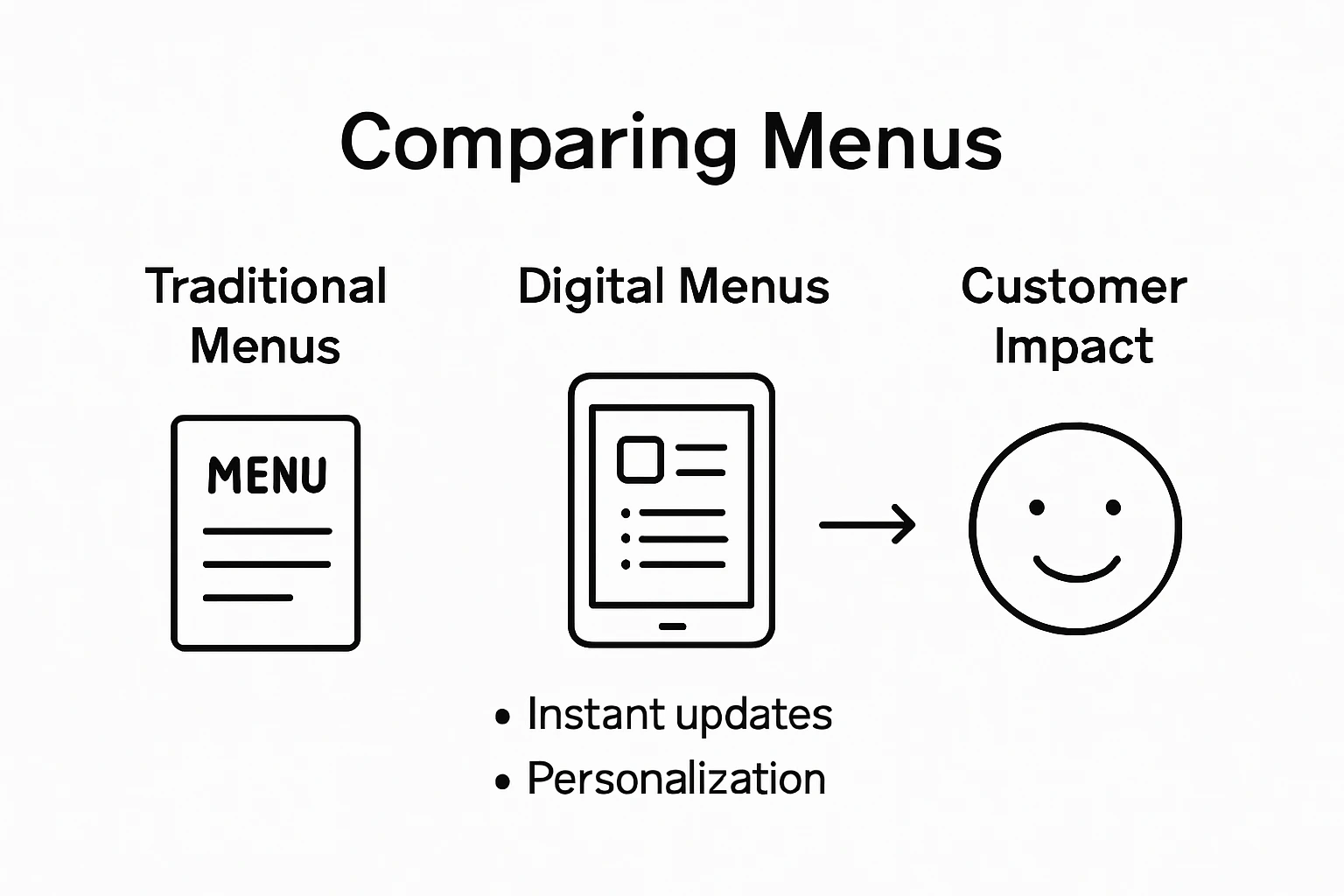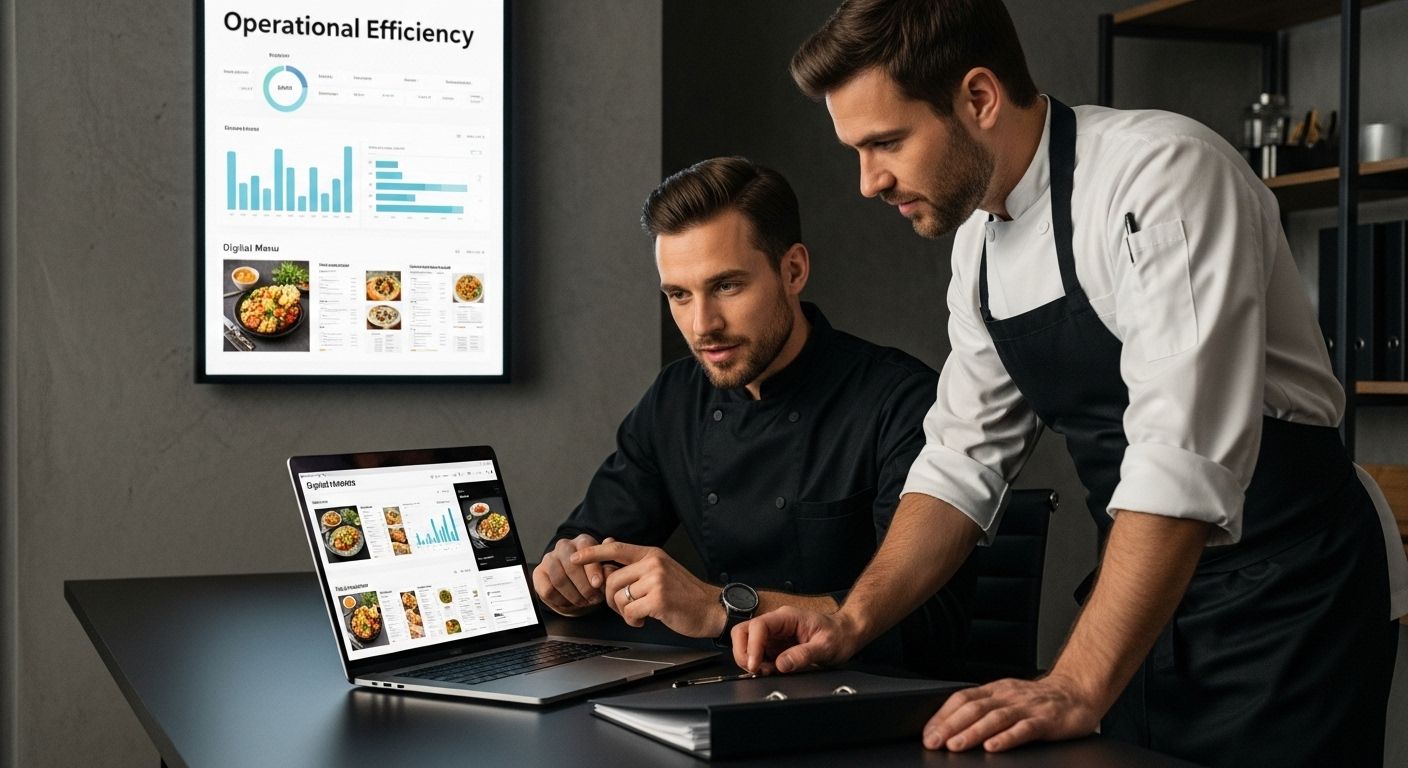Digital menus are rapidly taking over restaurants, hotels, and even cosy cafés. Think paper menus are still the gold standard? Over 70 percent of diners now say they prefer digital menus for the ability to see real-time updates and visual dish previews. Yet the real surprise is how these clever menus now act as powerful business tools, shaping what guests actually order and even how kitchens run behind the scenes.
Quick summary
Takeaway | Explanation |
|---|---|
Digital menus enhance customer engagement | They provide interactive features that personalise the dining experience and cater to individual customer preferences. |
Real-time updates increase operational efficiency | Restaurants can instantly modify menus and pricing, reducing delays and improving responsiveness to customer needs. |
Utilising data analytics supports better decision-making | Digital menus collect insights on customer preferences, enabling tailored marketing strategies and improved service offerings. |
Integration of AI enhances menu personalisation | Future advancements will leverage AI for real-time dietary recommendations and predictive ordering based on past patterns. |
Cost savings through reduced printing and waste | Digital menus lower printing costs and minimise food waste by improving inventory management through real-time data tracking. |
What are digital menus and their features?
Digital menus represent a transformative technological solution for restaurants, hotels, and hospitality venues seeking to modernise their dining experience. Unlike traditional printed menus, these innovative digital platforms offer interactive, dynamic ways of presenting culinary offerings to guests.
Core components of digital menus: Digital menus represent a transformative technological solution for restaurants, hotels, and hospitality venues seeking to modernise their dining experience. Unlike traditional printed menus, these innovative digital platforms offer interactive, dynamic ways of presenting culinary offerings to guests.

Technical functionality and user experience
Digital menus typically operate through cloud-based systems, enabling restaurants to manage content seamlessly across multiple platforms. Guests can interact with menus through touchscreens, QR codes, or dedicated mobile applications, receiving personalised recommendations and detailed dish information instantaneously.
The technological infrastructure supporting digital menus includes sophisticated backend systems that allow for:
Instant menu synchronisation across devices
Integrated payment processing
Customer feedback collection
Analytics and performance tracking
By embracing digital menu technologies, hospitality businesses can create more engaging, efficient, and responsive dining experiences that meet modern consumer expectations.
To clarify the main features and functionality of digital menus, the following table summarises their core components and what they offer for both customers and operators.
Why digital menus matter for modern dining experiences
In an increasingly technology-driven hospitality landscape, digital menus have emerged as a critical tool for restaurants seeking to enhance customer experience, operational efficiency, and competitive positioning. Explore emerging restaurant trends that highlight the importance of technological innovation.
Enhanced customer interaction and accessibility:
Digital menus transform dining experiences by providing unprecedented levels of interaction and personalisation. Key advantages for customers include:
Instant access to comprehensive dish information
Visual representations of menu items
Customisation options for dietary requirements
Multilingual menu support
Real-time nutritional and allergen details
Operational efficiency and business intelligence
Beyond customer experience, digital menus offer substantial benefits for restaurant management. These platforms enable businesses to:
Update pricing and menu items instantly
Reduce printing costs and environmental waste
Customisation options for dietary requirements
Track customer preferences and ordering patterns
Benefit area | For customers | For businesses |
|---|---|---|
Enhanced accessibility | Multilingual support and dietary info | Broader market reach and inclusivity |
Personalised experience | Customisation options, visual previews | Better understanding of customer preferences |
Real-time information | Up-to-date menu options and pricing | Immediate updates reduce miscommunication |
Operational efficiency | Faster ordering and reduced wait times | Streamlined workflows, reduced errors |
Environmental and cost savings | Less paper waste | Lower printing and menu update costs |
Data-driven improvements | Tailored recommendations from past behaviour | Analytics inform menu and marketing strategies |

How digital menus enhance operational efficiency
Digital menus represent more than a technological upgrade they are strategic tools that fundamentally transform restaurant operations. Discover cutting-edge restaurant efficiency strategies that can revolutionise your business approach.
Streamlining kitchen and staff workflows:
Digital menu systems create seamless communication channels between front-of-house and kitchen staff. By integrating order management, these platforms eliminate traditional communication bottlenecks, reducing human error and increasing overall operational speed.
Key workflow improvements include:
Precise portion and preparation instructions
Reduced printing and menu design costs
Enhanced pricing strategy capabilities
Minimised manual administrative tasks
The role of digital menus in customer engagement
Customer engagement represents a critical metric for success in modern hospitality, and digital menus have emerged as powerful tools for creating interactive, personalised dining experiences. Learn about innovative restaurant marketing techniques that can transform customer interactions.
Building customer loyalty through technology
Digital menus serve as more than information platforms they are sophisticated engagement tools that create memorable dining experiences. By providing comprehensive, accessible information and interactive features, restaurants can:
Demonstrate technological innovation
Reduce customer decision anxiety
Provide transparent dining information
Create memorable digital interactions
Encourage repeat visits through personalised experiences
The technological infrastructure of digital menus enables restaurants to collect valuable customer data, understand preferences, and develop targeted marketing strategies. This data-driven approach transforms passive menu viewing into an active, engaging customer journey that extends beyond the immediate dining experience.
By integrating digital menu technologies, hospitality businesses can create more meaningful, personalised connections with their customers, ultimately driving loyalty and differentiating themselves in a competitive marketplace.

Transform your digital menu advantage into seamless guest experiences
Are you ready to unlock the full potential of digital menus while eliminating the hidden frustrations that come with manual processes? In the article, you have seen how digital menus create real-time engagement, enable instant updates, and offer personalised dining for every guest. Yet, without a powerful reservation and table management system, even the most advanced menu solutions can fall short on guest satisfaction and operational efficiency. Missed bookings, no-shows, and limited insights remain persistent challenges for hospitality venues trying to offer exceptional experiences. Now is the moment to bridge menu innovation with effortless guest management. With Tableo’s all-in-one reservation platform, you get more than technology. You gain automated bookings, intelligent floor plans, and integrated communication tools that work in perfect harmony with your digital menu ambitions. Visit Tableo today to optimise your dining operations, reduce no-shows, and enhance loyalty. Make every interaction count and give your guests a reason to book again. Do not wait – transform your reservation system and let your digital menu work harder for you right away.
Frequently asked questions
Digital menus are electronic representations of a restaurant’s food and beverage offerings, accessible via devices such as tablets, smartphones, and touchscreen displays. They offer interactive and dynamic ways to present culinary offerings to guests.
Digital menus enhance customer experience by providing instant access to detailed dish information, interactive visual representations, and real-time updates. They also allow for customisation options tailored to dietary preferences, creating a more personalised dining experience.
Digital menus streamline communication between front-of-house and kitchen staff, reduce printing costs, and enable real-time inventory management. They also facilitate instant updates to menu items and pricing, improving overall operational efficiency.
Digital menu systems can integrate features that allow customers to provide feedback easily. This data can be analysed to understand preferences better, track customer satisfaction, and help restaurants optimise their offerings and service.
Ready to take bookings seriously?
Try Tableo’s free version for up to 100 covers monthly– no credit card, no fuss.
Free Version – Free Setup – Free Training – Free Support


Stephanie Paris
Gen-Z marketing coordinator bringing fresh energy to web and graphic design, with a weekend habit of chasing adventure.









